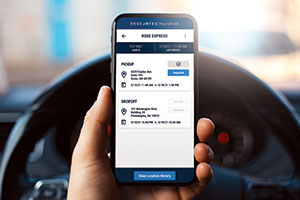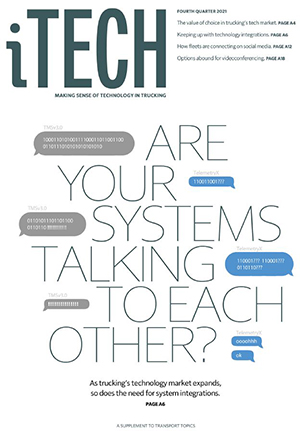Special to Transport Topics
Integrate and Excel

[Stay on top of transportation news: Get TTNews in your inbox.]
For decades, trucking and logistics companies have been investing in software and technologies to run their businesses more efficiently, improve safety and ensure compliance with government regulations.
Despite those clear benefits, this proliferation of technology has created a challenge of its own: Modern transportation companies must be able to effectively utilize data flowing from a growing number of discrete applications and systems.
To alleviate this problem, the industry’s technology vendors continue to build integrations to connect data streams from transportation management systems and various other back-office software programs, as well as the expanding array of technologies deployed in truck cabs, such as telematics systems, electronic logging devices and navigation software.
More Q4 iTECH Stories
►Using Social Media to Connect With Drivers, Customers
►Clevenger: The Value of Choice
►Dysart: Key Features of Videoconferencing for Trucking Firms
►Isaac, Trimble Among the First to Receive ELD Certification in Canada
These technology integrations — links between computers or computer programs that allow them to “talk” with each other — can connect fleets’ various in-house technologies and also externally link them with partners’ systems. Large technology providers often have hundreds or thousands of integration partners, which can even include rival technology firms.
“We’re trying to merge two systems together and make them work together in a way that reduces the complexity for the end user,” said Dacia Gulledge, product manager of interfaces at McLeod Software.
That often means connecting third-party systems that companies use for business-critical functions such as paying carriers and enabling messaging conversations, she said.
Integrations ease information flow and eliminate manual data entry while improving business management practices. These integrations can connect a variety of complex systems, but the goal is quite simple.
“At the end of the day, we are sending data from one system to another,” said Chris Orban, vice president of data science for Trimble Transportation.
The streamlined data sharing reduces the potential for human error and improves fleets’ operational accuracy.
“If I have five core systems with which I’m working and there isn’t an integration between them, I have people essentially doing data entry into five applications,” said Larry Kerr, president of EBE Technologies. “Obviously, that’s going to slow things down, it’s going to cost more in labor, and the more you touch data, the more likely it’s going to be wrong.”
Integrations can ease a variety of other functions, including trailer or shipment tracking.
“We already have done the heavy lifting of connecting to all the telematics devices,” said Dan Cicerchi, vice president and general manager of transportation management at Descartes. “We walk [carriers] through the information that we need to then activate and make available their data for the shipments.”
Some transportation companies build their own digital tools customized to meet their specific needs.

Tech vendors are connecting management and visibility software with drivers' mobile devices. (Descartes)
NFI evaluates every new need that arises to determine whether to purchase a vendor’s digital solution or build their own product, said Mike Hayden, vice president of transportation at the trucking and logistics provider.
“Our transportation ecosystem has really expanded as we add different vendors, new products and services,” he said. “We were finding that a dispatcher or a driver manager or logistics supervisor would start their day and suddenly they’re having to open up 15 browser windows to get into all of the different websites.”
The company’s technology teams recently built their own central system to “combine all of these different pieces to give the operators the information that they need right on one screen.”
NFI, based in Camden, N.J., ranks No. 16 on the Transport Topics Top 100 list of the largest for-hire carriers in North America.
Integrating with carriers’ custom platforms or apps usually isn’t much more work than meshing with technology vendors’ products, Trimble’s Orban said, because most of the in-house systems are built on a major vendor’s base software.
Creating and Maintaining Integrations
Some integration data is exchanged via methods such as secure file transfer protocol (SFTP), comma-separated values (CSV), hypertext markup language (HTML) or electronic data interchange (EDI). The most modern method is via an application programming interface (API).
APIs have transformed the digital space and have become essential for many modern technologies to function properly. A challenge with APIs is that they have a variety of fields, but the benefits outweigh the challenges, said Sriram Nagaswamy, vice president of engineering at FourKites.
“When we started out [with integrations], the whole process was very manual” and it could take a week to complete one, he said.
Five years ago he had to support a variety of different file types, but now 90% of FourKites’ integrations are through APIs.
“The primary reason why everybody just loves APIs is that they have simplified extremely archaic industries,” Nagaswamy said.
EBE published its APIs so integration partners can pull the information that they need.
“That allows them to pretty much work without EBE being involved,” Kerr said.
Even with APIs, integrations take time to set up and “can be challenging, because a lot of times you have things that seemingly fit together but yet don’t fit,” said Robert Brothers, vice president of product development at McLeod Software.
Plus, the last few years have brought a notable increase in the number of available “point solutions” — software or apps that perform specific services, including loadboard and driver workflow apps.
“We’ve seen an explosion in the number of companies trying to put a new solution into the marketplace,” he said.
Ongoing maintenance to update integrations when one partner changes part of its connected data stream also takes time, and “certainly has become just as significant to plan around” as initial integration implementation, said Matt Battista, senior vice president of information technology at NFI.
New regulatory measures such as ELD mandates and intensifying concerns about cybersecurity also add complexity.
“Adding layers of security can often cause us to have to revisit integrations that we’ve already done and have to enhance the way they function and make them more secure,” McLeod’s Gulledge said. “Regulatory changes come into play with maintenance as well.”
Tech developers that build these integrations report only tapping into data streams that customers feel comfortable sharing. For example, fleets initially might hesitate to share sensitive information such as pricing with tech vendors.
“When it comes to our data and what we want to specifically share with a vendor or with our partners, we just want to make sure that we’re doing that in the right way and we have control over what’s important to us,” NFI’s Battista said. “In this world of cybersecurity, it’s super important that we’re careful in how we are sharing that information.”
Integrations don’t simply involve meshing data streams. Significant work first goes into building trust with customers before they will even consider collaborating and sharing data with vendors, Trimble’s Orban said.
Deciding whether to integrate and with whom has taken on an interesting dynamic in the highly competitive transportation field. Mergers and acquisitions have complicated data sharing among technology suppliers that are both integration partners and competitors, but in many cases, these vendors have concluded that “coopetition” is necessary to best serve their customers.
“In the end, we gain more by working together,” McLeod’s Brothers said. “We don’t want to eliminate customers that have [other vendors’] products from being able to buy our product, so you just have to have that understanding that it’s in both of our interests to work together.”
The same is true on the fleet side.
“I think what they realize now is the visibility that comes with cooperating with multiple vendors is actually more valuable than operating within silos,” FourKites’ Nagaswamy said.
Data Standards
Conversations are taking place across the industry about tech and data standardization to increase systems’ compatibility and reduce or eliminate the need for integrations, but “I haven’t seen any real or significant progress at this point,” NFI’s Hayden said. “That’s really what forced us down the path of building it ourselves, because we didn’t see something coming in place in the immediate future that was going to solve it for us.”

Big rig braking is an engineering marvel. Host Michael Freeze finds out more about the advanced technology that halts 18-wheelers, no matter the weight, instantaneously. Hear a snippet above, and get the full program by going to RoadSigns.TTNews.com.
Nagaswamy said transportation is “progressing toward something like” standardization, which will further automate technologies and remove manual intervention. However, more time and investments are needed to achieve standardization.
Integrations boomed in the last couple of years, and vendors predict they will remain important for years to come as more software, apps and systems come to market.
“Certainly, there will be more capabilities,” Cicerchi said. “I think you’ll just have a bigger proliferation of other devices that are now able to share pertinent information about a particular shipment.”
And the value of integrations for improving efficiency is only expected to grow as transportation demand increases and more attention turns to enhancing the supply chain.
“I really get excited about the concept of a connected supply chain,” Orban said. “We have to make this exchange of data easier and faster so that we can do business better.”
Want more news? Listen to today's daily briefing below or go here for more info:





